Rolling your lawn can be a beneficial practice when done at the right time. One important factor to consider is the moisture content of the soil. The ideal time to roll your lawn is in the early spring when the ground is still somewhat moist. This period allows the roller to smooth out any minor bumps without compacting the soil excessively.
Rolling a lawn that is too wet can lead to soil compaction, which can harm the grass roots and hinder proper growth. It’s crucial to strike a balance and avoid rolling when the soil is overly saturated. On the other hand, waiting until the soil is too dry can also be problematic as the ground may crack under pressure, leading to uneven results.
Another key consideration when deciding when to roll your lawn is the type of grass you have. Cool-season grasses benefit from rolling in early spring as it helps in the recovery process after the harsh winter months. Warm-season grasses, on the other hand, may benefit more from rolling in late spring or early summer when they are actively growing.
Aside from the season, the time of day can also play a role in determining when to roll your lawn. It’s generally recommended to perform lawn rolling in the morning or late afternoon when the temperatures are cooler. Rolling during the heat of the day can stress the grass and lead to unnecessary damage.
Before rolling your lawn, it’s essential to assess its condition and plan accordingly. If your lawn has areas with excessive thatch buildup or compaction, rolling can help break up the soil and promote better air and water infiltration. However, if your lawn is relatively healthy and even, rolling may not be necessary.
Regular aeration can complement lawn rolling by loosening the soil and allowing for better penetration of nutrients and water. Aeration helps prevent soil compaction and promotes healthier root growth, making it an excellent practice to incorporate alongside rolling.
While rolling your lawn can offer several benefits, it’s essential to exercise caution and avoid overdoing it. Rolling too frequently or applying excessive pressure can lead to unintended consequences such as soil compaction and root damage. It’s important to strike a balance and monitor the condition of your lawn to determine the optimal timing for rolling.
Consulting with a professional landscaper or lawn care expert can provide valuable insights tailored to your specific lawn needs. They can recommend the most suitable timing for lawn rolling based on factors such as grass type, soil composition, and current condition of the lawn.
In conclusion, the best time to roll your lawn is in the early spring when the soil is still moist but not waterlogged. Consider the type of grass you have and its growth patterns to determine the most suitable timing for rolling. Remember to aerate your lawn regularly and seek professional advice if you’re unsure about when to roll your lawn for optimal results.

